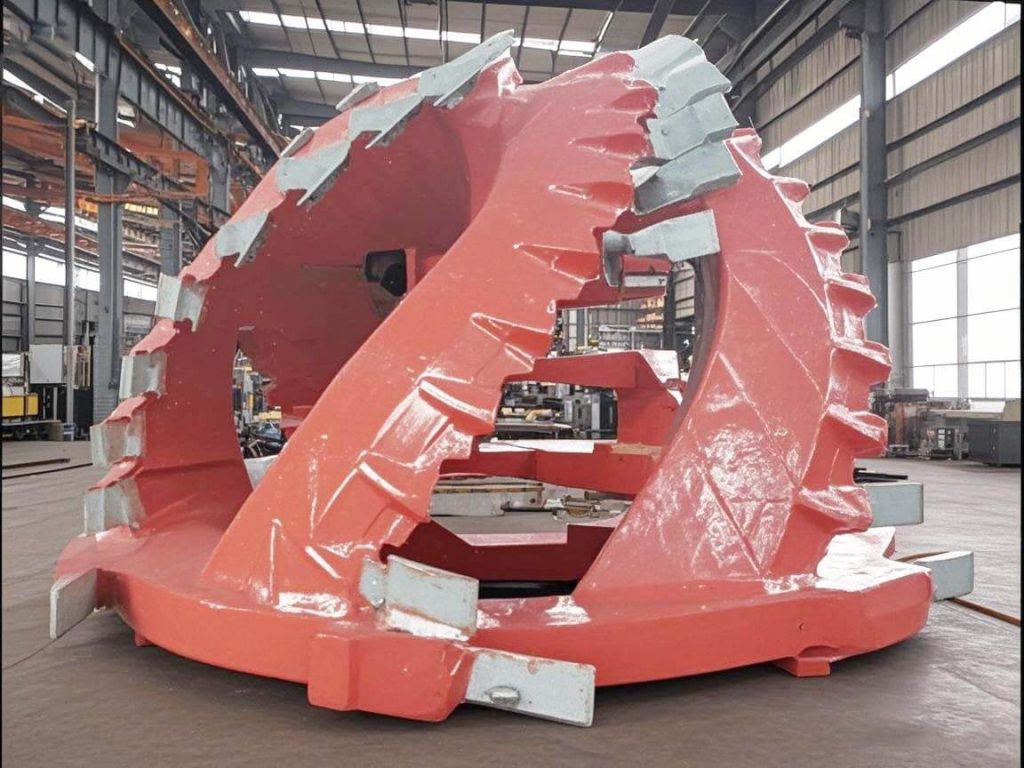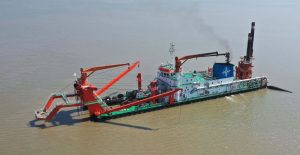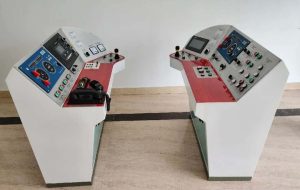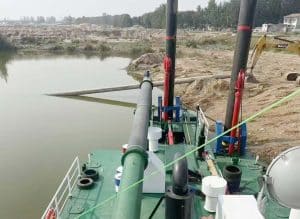Key Takeaways: Cutter Teeth Essentials
| Feature | Impact | Best Practice |
|---|---|---|
| Material Selection | Directly affects tooth lifespan | Match material to dredging conditions |
| Regular Inspection | Prevents catastrophic failures | Check after every 50-100 working hours |
| Tooth Design | Determines cutting efficiency | Use pick points for rock, chisels for softer material |
| Replacement Timing | Affects project costs & timelines | Replace at 40-50% wear to protect adapters |
| Arrangement Pattern | Influences wear distribution | Staggered pattern optimizes cutting performance |
Choosing the right cutter teeth for your dredger isn’t just about buying parts. It’s about maximizing productivity and slashing downtime. The wrong teeth can cost you thousands in lost production and repairs.
In this comprehensive guide, we’ll cut through the confusion and show you exactly what matters when selecting, maintaining, and optimizing cutter suction dredger teeth.
Introduction to Cutter Suction Dredger Cutter Teeth
Ever wondered what makes a cutter suction dredger actually cut? It’s the teeth.
Cutter teeth are the hardened cutting elements mounted on the rotating cutter head that directly engage with underwater materials. They’re the first point of contact with sediment, clay, or rock during dredging operations.
A modern cutter suction dredger excavating marine sediment
Close-up view of high-performance cutter teeth arrangement
Simply put, these specialized components are mission-critical. They determine:
- How efficiently your dredger excavates material
- Your operational costs (through fuel consumption)
- Project timelines and completion dates
- Maintenance frequency and overall equipment lifespan
A typical cutter head features 5-6 teeth mounted on each cutter arm, carefully positioned to optimize cutting performance while distributing wear evenly. Without properly functioning teeth, even the most powerful cutter suction dredger becomes virtually useless.
Let’s dive deeper into what makes these components so crucial for your dredging operations.
Types and Designs of Cutter Teeth
Not all cutter teeth are created equal. The design you choose should match the material you’re dredging. Using the wrong type is like trying to cut bread with a hammer—inefficient and potentially damaging.
Common Cutter Teeth Designs
Here’s a breakdown of the main types:
- Wide Chisel Teeth: Ideal for softer materials like silt and loose sand. Their broader cutting edge provides maximum material displacement in softer conditions.
- Narrow Chisel Teeth: Better for compact sand and soft clay. They offer a balance between cutting force and material displacement.
- Pick Point Teeth: Designed specifically for hard materials including rock and compacted clay. Their concentrated force at the tip can break apart tough substances.
- Combination Teeth: Feature hybrid designs for mixed material conditions, offering versatility for varying dredging environments.
“Selecting the right tooth design can increase production rates by up to 30% and reduce wear-related downtime significantly.” – Dredging Engineering Journal
Power Classification System
Cutter teeth are classified according to the power rating of the cutter head they’re designed for:
| Power Class | Cutter Power | Typical Applications |
|---|---|---|
| TSC04-T2 | 200-600 hp | Small to medium dredging projects |
| T3-T5 | 700-3,000 hp | Medium to large harbor maintenance |
| T6-T8 | 3,500-10,000 hp | Heavy-duty rock dredging, major port construction |
Matching tooth design to material conditions dramatically improves efficiency. For instance, when dredging in layered conditions with both soft sediment and rock, many operators use an adaptive approach by switching between tooth types.
Materials and Construction Technology
The material composition of cutter teeth determines their durability under punishing conditions. Let’s break down what goes into making these essential components.
Core Materials
Modern cutter teeth typically feature:
- High-strength alloy steel: Forms the tooth body, providing structural integrity while withstanding impact forces
- Tungsten carbide inserts: Extremely hard material used at cutting edges for maximum wear resistance
- HLC-type alloys: Advanced wear-resistant materials with specialized heat treatment for exceptional performance
The best cutter teeth aren’t just hard—they balance hardness with toughness. Too hard, and they fracture. Too soft, and they wear quickly.
Manufacturing Processes
Quality teeth undergo rigorous production processes:
- Precision casting to form the basic tooth shape
- CNC machining for dimensional accuracy
- Heat treatment to optimize hardness and impact resistance
- Surface treatment for enhanced wear protection
The most advanced teeth feature spray welding technology, where materials like nickel-based alloys or tungsten carbide are applied to high-wear areas. This creates a composite tooth with exceptional wear characteristics in specific areas while maintaining structural toughness elsewhere.
According to research published in the Wear Journal, properly applied composite surfaces can extend tooth life by 40-60% compared to conventional materials.
Working Mechanics of Cutter Teeth
Understanding how cutter teeth actually work helps you optimize your dredging operation. It’s not just about rotating teeth—it’s about complex mechanical interactions.
The Cutting Motion
Cutter teeth operate through a compound motion that combines:
- Rotational movement of the cutter head (typically 20-30 RPM)
- Swing motion of the dredger itself (left to right)
- Vertical adjustment of cutting depth
This creates a spiral cutting path where each tooth takes a “bite” out of fresh material with every rotation.
Strategic Tooth Arrangement
Ever notice how teeth on a cutter head aren’t lined up perfectly? There’s science behind that.
The staggered pattern ensures:
- Each tooth contacts fresh material rather than following the same path
- Wear is distributed more evenly across all teeth
- Cutting forces are balanced to reduce vibration
- Material flow to the suction inlet is optimized
Staggered arrangement of cutter teeth on a modern dredger head
Visualization of compound cutting motion during operation
The interaction between teeth and soil creates significant forces. In hard rock, a single tooth can experience forces exceeding 5,000 kg. This is why both material selection and geometry are crucial for performance.
As research from TU Delft demonstrates, optimizing the attack angle of cutter teeth can reduce required cutting force by up to 25% in certain materials.
Wear Mechanisms and Failure Modes
Cutter teeth don’t just “wear out”—they fail in specific, predictable ways. Recognizing these patterns helps you prevent costly breakdowns.
Types of Wear
Five main wear mechanisms affect cutter teeth:
- Abrasive wear: The most common type, occurring when hard particles (like sand) scrape against tooth surfaces
- Adhesive wear: Material transfer between surfaces in close contact under pressure
- Impact wear: From repeated collisions with rocks or other hard objects
- Fatigue wear: Microscopic cracks that develop over thousands of loading cycles
- Corrosion wear: Chemical deterioration accelerated by saltwater and abrasive action
Research shows that abrasive wear and fracture are the predominant failure modes for most cutter teeth. In highly abrasive conditions, teeth can lose up to 5% of their mass per 100 operating hours.
Warning Signs of Impending Failure
Watch for these red flags:
- Uneven wear patterns across teeth on the same arm
- Visible cracking, especially near the mounting points
- Reduced dredging production rates
- Increased power consumption for the same material
- Excessive vibration in the cutter head assembly
“The cost of unexpected tooth failure goes far beyond replacement parts. Production losses often exceed 10 times the cost of the tooth itself.” – Dredging Operations Manual
According to a comprehensive study of dredging operations, proactive replacement based on wear monitoring can reduce overall dredging costs by 8-12% compared to reactive replacement after failure.
Maintenance Best Practices
Proper maintenance isn’t just about fixing problems—it’s about preventing them. For cutter teeth, this means systematic inspection and timely replacement.
Inspection Routines
Follow this simple inspection schedule:
- Daily visual checks: Quick inspection for obvious damage or excessive wear
- Weekly detailed inspection: Measurement of wear patterns and tooth dimensions
- Monthly comprehensive assessment: Complete cutter head inspection including adapters and connections
Use digital photography to document wear progression. This creates a valuable record for planning maintenance and identifying problematic patterns.
When to Replace Cutter Teeth
Don’t wait until teeth fail completely. Ideally, replace teeth when:
- They reach 40-50% wear (measured by mass or dimension)
- Uneven wear patterns develop
- Any cracking is visible
- Production rates begin to decline
Early replacement protects the more expensive adapter components and prevents cascade failures that can damage the entire cutter head.
Safety Procedures
Maintenance of cutter teeth involves significant hazards. Always:
- Follow lockout/tagout procedures before any work
- Use proper lifting equipment—teeth can weigh 30-100 kg each
- Wear appropriate PPE including impact-resistant gloves and eye protection
- Have at least two personnel present during replacement operations
Modern cutter suction dredgers increasingly feature hydraulic tooth replacement systems or even robotic systems to improve safety and efficiency during maintenance.
The International Association of Dredging Companies provides detailed safety guidelines specific to dredging equipment maintenance.
Optimization Strategies for Increased Performance
Strategic optimization of your cutter teeth setup can dramatically improve dredging performance. Here’s how to squeeze maximum productivity from your equipment.
Performance Monitoring
You can’t improve what you don’t measure. Track these key metrics:
- Production rate: Cubic meters dredged per hour
- Specific energy consumption: kWh per cubic meter
- Tooth wear rate: Weight or dimension loss per operating hour
- Replacement frequency: Operating hours between replacements
Modern dredgers often feature digital monitoring systems that track cutter power, torque, and production in real-time. These data points help identify the optimal balance between cutting rate and wear.
Economic Optimization
The most cost-effective approach balances:
| Factor | Impact | Optimization Strategy |
|---|---|---|
| Tooth quality | Higher initial cost, longer life | Calculate cost per cubic meter, not cost per tooth |
| Replacement timing | Earlier replacement = higher parts cost but protected adapters | Find optimal replacement point based on wear curve |
| Cutting technique | Affects tooth life and production rate | Adjust swing speed and cutter RPM for material conditions |
Leading dredging contractors report that proper tooth selection and maintenance can improve project economics by 15-20% through reduced downtime and increased production rates.
Research from the World Organization of Dredging Associations indicates that monitoring-based optimization can reduce the total cost of dredging operations by up to 18% compared to traditional fixed-interval maintenance approaches.
Future Innovations in Cutter Teeth Technology
The future of cutter teeth technology is evolving rapidly. Stay ahead of the curve with these emerging trends.
Advanced Materials
Tomorrow’s cutter teeth will likely feature:
- Multi-element trace alloys: Custom-formulated for specific dredging conditions
- Ceramic-metal composites: Offering unprecedented hardness without brittleness
- Gradient materials: With properties that transition throughout the tooth body
Research in advanced materials science is already yielding alloys with 30-40% longer service life than conventional options.
Smart Monitoring Systems
Next-generation cutter teeth will incorporate:
- Embedded sensors to monitor wear in real-time
- Predictive analytics to forecast optimal replacement timing
- Automated adjustment of dredging parameters based on tooth condition
These technologies promise to eliminate unexpected failures while maximizing equipment utilization.
Environmental Considerations
Sustainability is increasingly important in dredging operations:
- Low-noise cutting technologies for environmentally sensitive areas
- Reduced turbidity designs that minimize suspended sediment
- Energy-efficient tooth geometries that lower carbon footprint
According to the World Association for Waterborne Transport Infrastructure, environmentally optimized dredging equipment will be standard within the decade as regulations tighten globally.
Choosing the Right Cutter Teeth for Your Project
Selecting the optimal cutter teeth involves matching their characteristics to your specific project requirements.
Assessment Criteria
Evaluate your needs based on:
- Material characteristics: Hardness, abrasiveness, and heterogeneity
- Production requirements: Volume targets and project timeline
- Equipment specifications: Cutter power, diameter, and rotation speed
- Economic constraints: Initial budget vs. lifecycle costs
Application Scenarios
Different projects demand different approaches:
| Scenario | Recommended Tooth Type | Key Considerations |
|---|---|---|
| Harbor maintenance (soft silt/clay) | Wide chisel teeth | Focus on volume over cutting force |
| River widening (sand with gravel) | Narrow chisel with reinforced edges | Balance between cutting and wear resistance |
| Mining operations (compacted material) | Pick point teeth with tungsten inserts | Maximum penetration force and wear resistance |
| Rock dredging (limestone, sandstone) | Heavy-duty pick points with specialized geometry | Impact resistance and optimized attack angle |
ROI Considerations
Calculate the true cost of your cutter teeth by considering:
- Initial purchase price
- Expected service life under your conditions
- Installation and replacement labor costs
- Production impact (cubic meters per tooth)
- Potential downtime costs from premature failure
“The most expensive tooth is rarely the most expensive solution. True cost must be calculated across the entire dredging operation.” – Dredging Economic Analysis
For expert guidance on selecting the optimal cutter teeth for your specific conditions, consult with specialists who understand both the technical and economic aspects of dredging operations.
Why Ocean Blue Company’s Cutter Teeth Solutions Stand Out
With over 25 years of experience in dredging equipment, Ocean Blue Company offers distinct advantages for operations seeking reliability and performance.
Expertise and Quality Assurance
Ocean Blue’s competitive edge includes:
- Specialized manufacturing: Purpose-built production facilities focused exclusively on dredging components
- Rigorous testing: Every tooth undergoes hardness testing, dimensional verification, and metallurgical analysis
- Field-proven designs: Products refined through decades of real-world application data
Our cutter suction dredger teeth are engineered specifically for maximum service life while maintaining optimal cutting performance.
Customization Capabilities
Unlike off-the-shelf solutions, Ocean Blue offers:
- Custom tooth designs for specific material conditions
- Proprietary alloy formulations for challenging environments
- Adaptive tooth systems that can be reconfigured as project conditions change
Quality control testing at Ocean Blue’s manufacturing facility
Custom-designed cutter teeth for specialized applications
Comprehensive Support
Our commitment extends beyond simply supplying parts:
- Technical consultation to optimize tooth selection for your specific conditions
- Performance monitoring and wear analysis services
- Emergency replacement logistics to minimize downtime
- Ongoing research and development to continuously improve product performance
With operations in global markets including Uzbekistan, Serbia, and Argentina, Ocean Blue has the experience to support dredging operations in any environment worldwide.
FAQ Section: Cutter Suction Dredger Cutter Teeth
How often should cutter teeth be replaced?
Replacement intervals vary based on material conditions, but generally, teeth should be inspected after every 50-100 operating hours and replaced when they reach approximately 40-50% wear. Early replacement prevents damage to more expensive components like adapters and hubs.
Can I mix different tooth types on the same cutter head?
While possible in some circumstances, mixing tooth types generally creates uneven cutting forces and accelerated wear. It’s better to use a consistent tooth design selected for the predominant material condition. In layered grounds, changing all teeth between distinct layers may be more effective.
What causes premature tooth failure?
Common causes include using teeth inappropriate for the material conditions, improper installation (especially torquing), excessive cutter power for the tooth class, hidden obstructions like metal debris, and improper dredging technique such as excessive swing speed.
Are more expensive teeth always better?
Not necessarily. The optimal tooth is the one that provides the lowest cost per cubic meter dredged in your specific conditions. Sometimes, using more economical teeth with more frequent replacement is more cost-effective than premium options, especially in less abrasive materials.
How do I calculate the true cost of cutter teeth?
Divide the total cost (purchase price + installation labor + downtime cost) by the total volume dredged during the tooth’s service life. This gives you cost per cubic meter, which is the most accurate measure for comparison between options.
Conclusion: Maximizing Your Dredging Investment
The humble cutter tooth might seem like just another wear part, but it’s actually the cornerstone of your entire dredging operation. Getting it right pays dividends throughout your project.
Let’s recap the key points:
- Match tooth design and material to your specific dredging conditions
- Implement regular inspection and proactive replacement
- Calculate true costs based on production rates, not just purchase price
- Consider the entire system when optimizing tooth performance
- Stay informed about emerging technologies and materials
With over 25 years of experience providing high-quality dredging equipment worldwide, Ocean Blue Company offers the expertise you need to maximize productivity and minimize downtime.
Ready to optimize your dredging operation?
Contact our specialists today for a personalized consultation on the ideal cutter teeth solution for your specific project conditions.
Explore Our Dredging Solutions
This article was last updated on May 15, 2025, to reflect the latest advancements in cutter tooth technology and best practices.







